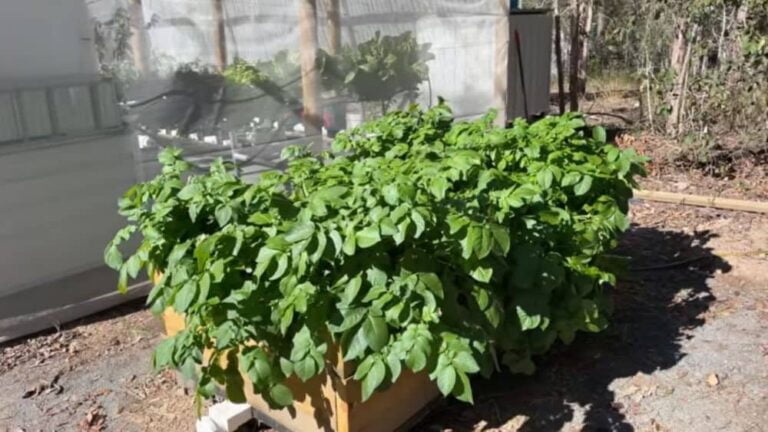Know the truth about hydroponic potatoes: Myths debunked
Recently, there has been a clear shift around the world toward more environmentally friendly farming methods. Hydroponics is the process of growing plants without dirt. It has been around for a while, but hydroponic potatoes are still new. Could growing potatoes in hydroponics be the key to healthier, more environmentally conscious farming?
Explore how potatoes grow in water and how to plant hydroponic potatoes indoors.
Basics of Hydroponic Potatoes
Even though hydroponic potatoes have been around for a while, they’ve been getting attention because they might be better than regular farming. Rather than growing plants in soil, hydroponic systems cultivate them in water solutions full of nutrients. With this method, potatoes are grown in a controlled environment. This lowers the risks of pests like the Colorado potato beetle and the chance of diseases spreading by soil.
The Process of Growing Potatoes in Hydroponics
If you want to know how to grow hydroponic potatoes, you need to follow an organized, step-by-step process:
- Setting up the system: For potatoes, a deep water culture (DWC) system is the right place to start. This method submerses the tubers just right so they can grow in the most efficient way possible.
- Choosing the Right Seed: Choose high-quality seed potatoes. Avoid seeds from the grocery store because they may have been treated to stop sprouting.
- Planting: Once your system is ready and the seeds have grown, put them in the hydroponic system. Ensure the sprouts stay above the water and the tubers are well buried.
- Nutrient Solution: This is what potato hydroponics needs to grow. The right nutrients, such as potassium, phosphorus, and nitrogen, must be in the mix. For maximum growth, check pH levels often to ensure they stay between 5.8 and 6.2.
- Grow and harvest: You should see sprouts become plants and roots grow if you maintain the right conditions for potato growth. Hydroponic potatoes usually harvest faster than soil-grown potatoes.
Advantages of Hydroponic Potato Cultivation
There are many advantages to hydroponic farming, as well as being innovative:
Faster Growth: Hydroponically grown potatoes grow faster, which is one of the biggest benefits. Planting these potatoes in a controlled setting often results in faster growth than planting them in the ground.
Farming All Year: Traditional farming limits what can be grown. You can get steady supplies from hydroponic systems, especially indoor systems.
Less water use: Hydroponic systems recycle water, making them more eco-friendly than traditional farming.
Better Quality and Yield: In a controlled environment, disease and pest infestation chances are very low. It usually means more and better potatoes.
What About Hydroponic Sweet Potatoes?
Want to grow delicious sweet potatoes in less space and resources? Hydroponic sweet potatoes are the answer! This soil-free method offers faster growth, higher yields, and reduced pest and disease risk. While their trailing vines need extra care, hydroponic sweet potatoes offer an exciting and rewarding addition to your garden. Ready to get started? Look for sweet potatoes that are suited to hydroponic systems.
Can You Really Grow Hydroponic Sweet Potatoes?
Planting sweet potatoes in water might seem strange, but it’s definitely possible! Unlike regular potatoes, sweet potatoes grow on vines rather than in tubers.
While sweet potatoes thrive in hydroponic systems, their trailing vines need extra space. It can make them slightly more challenging to care for hydroponically. However, with the right method and attention, you can successfully produce hydroponic sweet potatoes and enjoy all the benefits of hydroponic growing.
Common Misconceptions About Hydroponic
Potatoes
Like any novel idea, hydroponic potatoes have myths. Let’s get things straight:
Taste and Feel: A common myth is that potatoes grown in water taste less delicious than those produced in dirt. It is not true. Nutritional solutions significantly influence potato taste, and some think potatoes cultivated in water taste even better.
It’s too complicated to understand: Precision is paramount, but hydroponic gardening is easy enough that even a newbie can do it with the help of many guides and kits.
Yield Quantity: Hydroponics grows fewer potatoes than soil. This is not true. If potato growing conditions are properly maintained, hydroponic systems can produce as much as or more than conventional agriculture.
Hydroponic farming could be the key to sustainable, efficient, and environmentally friendly farming. We now know that growing hydroponic potatoes is possible and has many perks that could change how we think about farming. It looks like an excellent idea, whether you’re a farmer looking for more efficient ways to grow crops or a buyer wondering about the future of your food.
Challenges in Growing Hydroponic Potatoes
Even though this farming looks winning, it has some flaws. Hydroponic potatoes have some problems. These are the technical aspects of setting up the system and ensuring the right conditions for growth.
Many people need help maintaining a steady source of nutrients. Potatoes need certain macro- and micronutrients. If you are a newbie to hydroponics for potatoes, it can be challenging to ensure the correct nutrient solution.
Keeping pests and diseases at bay is another task. Even though soil-borne diseases are less likely to spread in hydroponics, aphids and fungal infections can still happen. It’s critical to watch the crop and find problems early.
Real-life Case Studies
The following are some true stories of farmers who grow hydroponic potatoes:
- John’s Hydroponic Potato Business: John, an Ohio farmer, began with a small hydroponic system in his backyard. He got 20% more crops than soil-based foods over time. Maintaining a stable pH of the nutrient mix was one of John’s most important lessons.
- A Sweet Success for Sarah: Sarah, from Florida, chose to try growing sweet potatoes in a hydroponic system. In addition to producing, the sweet potatoes tasted better and were more precious than those grown in dirt. Her project showed that different kinds of potatoes could thrive well in hydroponic setups.
Frequently Asked Questions (FAQ)
What are the main benefits of growing potatoes hydroponically?
Hydroponic farming has benefits like faster growth, growing potatoes yearly, using less water, and making plants less vulnerable to pests and diseases.
Which hydroponic systems work best for growing potatoes?
Deep water culture (DWC) systems work well for hydroponically growing potatoes. They cover the tubers well enough to provide an ideal environment for growth.
How do we ensure the nutrient solution in a hydroponic potato system stays balanced?
Check the pH level of the nutrient solution and make changes as needed to keep it between 5.8 and 6.2. Ensure it has nutrients like nitrogen, potassium, and phosphorus that your plant needs.
What problems can occur when growing hydroponic potatoes? And how can they be fixed?
Keeping the proper levels of nutrients and getting rid of pests like aphids and fungal infections are some of the problems that need to be solved. Regular monitoring and finding problems early can reduce their severity.
What are the benefits of hydroponic potato farming for the environment?
Hydroponic potato farming saves water and chemicals by using less than traditional methods. It saves water and protects the environment.
Do potatoes grown in water or soil taste and feel better??
In some cases, water-grown potatoes taste even better than soil-grown potatoes. Nutrient balance in a hydroponic system can impact taste and quality.
What do you need to make a hydroponic potato farm, and how much does it cost to start?
A hydroponic potato system may require tools such as grow lights, pumps, and containers. Costs can differ, but the initial investment may be higher, but it may pay off in the long run by saving water and increasing yields.
Potatoes Grow in Water: Is It Sustainable?
The key to a better gardening future lies in hydroponic potatoes. Since these methods do not require soil, they use much less water, which is critical because water shortages are becoming more prevalent globally.
Also, growing potatoes in hydroponics can stop land degradation, a big problem for the earth. Since there is no need for herbicides or pesticides, there is also a big drop in chemical waste, which protects nearby water systems.
But it’s imperative to remember that hydroponic systems need power to work. Getting this energy from naturally renewable sources can make them even more environmentally friendly.
Conclusion
Moving from dirt to hydroponic systems has changed farming dramatically. Hydroponic potatoes are viable because they have clear benefits and could be used as a more environmentally friendly method. As with any gardening method, there are still problems, but the success stories and environmental benefits make a compelling argument for using this method more often.
References
- Smith, J. (2020). Hydroponic Potato Growth: A Comparative Study. Journal of Sustainable Agriculture.
- Williams, L. (2021). Taste Test: Hydroponic vs. Soil-Grown Potatoes. Food Science Review.
- Rodriguez, P. (2019). Environmental Benefits of Hydroponic Farming. EcoFuture Journal.
A Call to Act
Are you interested in hydroponic potatoes? Would you like to share a good or bad experience? Talk to others in the comments below. Please read our other pieces about current farming trends and methods to learn more about sustainable farming.

Meet Milan Cole, your urban gardening pro!
Milan Cole, chief content writer at Maven Gardening and an urban gardening expert, is passionate about helping city dwellers cultivate their green thumbs. Armed with extensive horticultural knowledge, Milan provides practical advice for overcoming urban gardens’ challenges, like limited space, water scarcity, and reduced sunlight.
His expertise extends beyond traditional methods, encompassing innovative approaches like hydroponic and aquaponic systems and sustainable gardening practices. Milan skillfully adapts these techniques to urban environments, considering factors like pollution and climate change.
In his clear and concise writing, Milan offers actionable solutions for anyone wanting to bring life to an urban space. He shares valuable insights into growing herbs in tight spaces, maximizing the potential of window boxes, and transforming even the most miniature balconies into thriving green oases.
Milan’s guidance is straightforward and practical, making it ideal for anyone looking to cultivate their own urban garden, regardless of prior experience.
Join Milan Cole on your journey to metropolitan Eden!



